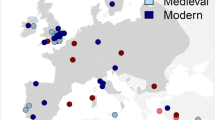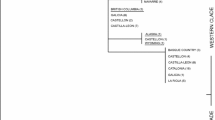Abstract
Introgression and admixture from domestic or foreign conspecifics into wild populations are of great concern in wildlife conservation. The issue is of particular interest in ungulates where translocations and re-introductions have been common practice. In Europe, the only large remaining wild populations of reindeer (Rangifer tarandus L.) are found in the mountainous habitats of southern Norway. These populations have during the last centuries been exposed to extensive habitat modifications and periods of contact with domestic reindeer. Through analyses of ancient and extant mitochondrial DNA (mtDNA) we document extensive intra- and inter-population genetic changes during the last millennium. Our data indicate population reduction within a short time interval during the 11th–12th century during a period when mass trapping of reindeer was common. Significant differentiation between the ancient herds suggests an ancient genetic structuring of the reindeer herds in southern Norway, although not as strong as between modern herds. Two different mtDNA lineages characterized the ancient herds. A Bayesian approach to reconstruct the recent evolutionary history suggests that the reindeer herds in southern Norway originate from two populations separated in different refugia during the last glacial period. The presence of two additional extant lineages, characteristic of domestic herds, suggests substantial introgression into the native wild reindeer. The putatively different refugial origins of the lineages represented by the extant herds in Rondane/Dovre, Hardangervidda and those with a mainly domestic origin may well reflect different adaptations to environmental conditions, including degree of human interference. Further research on this issue would provide important insights for conservation priorities and a sustainable and flexible management strategy for the remaining wild reindeer herds in the Scandinavian mountains.





Similar content being viewed by others
References
Adams LG, Dale BW (1998) Timing and synchrony of parturition in Alaskan caribou. J Mamm 79:287–294
Allendorf FW, Luikart G (2007) Conservation and the genetics of populations. Blackwell, Malden
Allendorf FW, Leary RF, Spruell P, Wenburg JK (2001) The problems with hybrids: setting conservation guidelines. Trends Ecol Evol 16:613–622
Andersen R, Hustad H (2004) Villrein & Samfunn. En veiledning av bevaring og bruk av Europas siste villreinfjell. NINA Temahefte, 27, Norsk institutt for naturforskning, Trondheim (In Norwegian)
Anderson TM, vonHoldt BM, Candille SI et al (2009) Molecular and evolutionary history of melanism in North American gray wolves. Science 323:1339–1343
Anderung C, Baubliene J, Daugnora L, Götherstrom A (2006) Medieval remains from Lithuania indicate loss of a mitochondrial haplotype in Bison bonasus. Mol Ecol 15:3083
Bandelt HJ, Forster P, Röhl A (1999) Median-joining networks for inferring intraspecific phylogenies. Mol Biol Evol 16:37–48
Baskin LM (2005) Number of wild and domestic reindeer in Russia in the late 20th century. Rangifer 25:51–58
Beaumont MA, Zhang WY, Balding DJ (2002) Approximate Bayesian computation in population genetics. Genetics 162:2025–2035
Bjørnstad G, Røed KH (2010) Museum specimens reveal changes in the population structure of northern Fennoscandian domestic reindeer in the past one hundred years. Anim Genet 41:281–285
Bjørnstad G, Flagstad Ø, Hufthammer AK, Røed KH (2012) Ancient DNA reveals a major genetic change during the transition from hunting economy to reindeer husbandry in northern Scandinavia. J Archaeol Sci 39:102–108
Bowman J, Kidd AG, Gorman RM, Schulte-Hostedde AI (2007) Assessing the potential for impacts by feral mink on wild mink in Canada. Biol Conserv 139:12–18
Campos PF, Kristensen T, Orlando L et al (2010) Ancient DNA sequences point to a large loss of mitochondrial genetic diversity in the saiga antelope (Saiga tatarica) since the Pleistocene. Mol Ecol 19:4863–4875
Clark PU, Dyke AS, Shakun JD et al (2009) The last glacial maximum. Science 325:710–714
Cornuet JM, Ravigne V, Estoup A (2010) Inference on population history and model checking using DNA sequence and microsatellite data with the software DIYABC (v1.0). BMC Bioinform 11:401
Couturier S, Brunelle J, Vandal D, Stmartin G (1990) Changes in the population-dynamics of the George River caribou herd, 1976–87. Arctic 43:9–20
Drummond AJ, Rambaut A (2007) BEAST: Bayesian evolutionary analysis by sampling trees. BMC Evol Biol 7:214
Edmands S (2007) Between a rock and a hard place: evaluating the relative risks of inbreeding and outbreeding for conservation and management. Mol Ecol 16:463–475
Excoffier L, Laval G, Schneider S (2005) Arlequin (version 3.0): an integrated software package for population genetics data analysis. Evol Bioinform 1:47–50
Festa-Bianchet M, Ray JC, Boutin S, Côté S, Gunn A (2011) Conservation of caribou (Rangifer tarandus) in Canada: an uncertain future. Can J Zool 89:419–434
Feulner PGD, Gratten J, Kijas JW et al (2013) Introgression and the fate of domesticated genes in a wild mammal population. Mol Ecol 22:4210–4221
Fitzpatrick BM, Johnson JR, Kump DK et al (2010) Rapid spread of invasive genes into a threatened native species. Proc Natl Acad Sci USA 107:3606–3610
Flagstad Ø, Røed KH (2003) Refugial origins of reindeer (Rangifer tarandus L.) inferred from mitochondrial DNA sequences. Evolution 57:658–670
Frankham R (2005) Genetics and extinction. Biol Conserv 126:131–140
Goedbloed DJ, Megens HJ, van Hooft P et al (2013) Genome-wide single nucleotide polymorphism analysis reveals recent genetic introgression from domestic pigs into Northwest European wild boar populations. Mol Ecol 22:856–866
Hansen BB, Aanes R, Herfindal I, Kohler J, Sæther BE (2011) Climate, icing, and wild arctic reindeer: past relationships and future prospects. Ecology 92:1917–1923
Henriksen V, Indrelid S (1979) Vidda og mennesket. In: Nyquist P (ed) Hardangervidda. Grøndahl & Søns Forlag AS, Oslo (In Norwegian), pp 46–149
Hofreiter M, Serre D, Poinar HN, Kuch M, Pääbo S (2001) Ancient DNA. Nat Rev Gen 2:353–359
Hufthammer AK, Bratbak OF, Indrelid S (2011) A study of bone remains and butchery patterns from medieval mass-hunting of reindeer in the South Norwegian mountain districts. Quat Int 238:55–62
Indrelid S, Hufthammer AK (2011) Medieval mass trapping of reindeer at the Hardangervidda mountain plateau, South Norway. Quat Int 238:44–54
Jordhøy P (2008) Ancient wild reindeer pitfall trapping systems as indicators for former migration patterns and habitat use in the Dovre region. Rangifer 28:79–87
Jordhøy P, Binns SK, Hoem SA (2005) Gammel jakt- og fangstkultur som indikator for eldre tiders jaktorganisering, ressurspolitikk og trekkmønster hos rein i Dovretraktene. NINA Rapport 19 (In Norwegian)
Kidd AG, Bowman J, Lesbarreres D, Schulte-Hostedde AI (2009) Hybridization between escaped domestic and wild American mink (Neovison vison). Mol Ecol 18:1175–1186
Kimura M (1980) A simple method for estimating evolutionary rates of base substitutions through comparative studies of nucleotide-sequences. J Mol Evol 16:111–120
Laikre L, Schwartz MK, Waples RS, Ryman N (2010) Compromising genetic diversity in the wild: unmonitored large-scale release of plants and animals. Trends Ecol Evol 25:520–529
Lamaze FC, Garant D, Bernatchez L (2013) Stocking impacts the expression of candidate genes and physiological condition in introgressed brook charr (Salvelinus fontinalis) populations. Evol Appl 6:393–407
Mager KH, Colson KE, Hundertmark KJ (2013) High genetic connectivity and introgression from domestic reindeer characterize northern Alaska caribou herds. Conserv Genet 14:1111–1123
Matthews JA, Dresser PQ (2008) Holocene glacier variation chronology of the Smørstabbtindan massif, Jotunheimen, southern Norway, and the recognition of century- to millennial-scale European neoglacial events. Holocene 18:181–201
Mikkelsen E (1994) Fangstprodukter i vikingtidens og middelalderens økonomi. Organiseringen av massefangst av villrein på Dovre. Universitetets Oldsaksamlings Skrifter, Ny rekke 18, 1–218 Oslo (In Norwegian)
Moe D (1973) Studies in the Holocene vegetation development on Hardangervidda, southern Norway. I. The occurrence and origin of pollen of plants favored by man’s activity. Norw Arch Rev 6:67–73
Nesje A, Bjune AE, Bakke J et al (2006) Holocene palaeoclimate reconstructions at Vanndalsvatnet, western Norway, with particular reference to the 8200 cal. yr BP event. Holocene 16:717–729
Norén K, Kvaløy K, Nystrøm V et al (2009) Farmed arctic foxes on the Fennoscandian mountain tundra: implications for conservation. Anim Conserv 12:434–444
Oliveira R, Godinho R, Randi E, Alves PC (2008) Hybridization versus conservation: are domestic cats threatening the genetic integrity of wildcats (Felis silvestris silvestris) in Iberian Peninsula? Phil Trans R Soc B 363:2953–2961
Panzacchi M, Van Moorter B, Jordhøy P et al (2013) Learning from the past to predict the future: using archaeological findings and GPS data to quantify reindeer sensitivity to anthropogenic disturbance in Norway. Landsc Ecol 28:847–859
Polfus JL, Hebblewhite M, Heinemeyer K (2011) Identifying indirect habitat loss and avoidance of human infrastructure by northern mountain woodland caribou. Biol Conserv 144:2637–2646
Price EO (1984) Behavioral-aspects of animal domestication. Q Rev Biol 59:1–32
Randi E (2008) Detecting hybridization between wild species and their domesticated relatives. Mol Ecol 17:285–293
Reimer PJ, Baillie MGL, Bard E et al (2009) Intcal09 and Marine09 radiocarbon age calibrationcurves, 0–50,000 years cal BP. Radiocarbon 51:1111–1150
Reimers E (1972) Growth in domestic and wild reindeer in Norway. J Wildl Manag 36:612–619
Reimers E, Colman JE (2006) Reindeer and caribou (Rangifer tarandus) response towards human activities. Rangifer 26:56–71
Reimers E, Røed KH, Colman JE (2012) Persistence of vigilance and flight response behaviour in wild reindeer with varying domestic ancestry. J Evol Biol 25:1543–1554
Røed KH, Mossing T, Nieminen M, Rydberg A (1987) Transferrin variation and genetic structure of reindeer populations in Scandinavia. Rangifer 7:12–21
Røed KH, Flagstad Ø, Nieminen M et al (2008) Genetic analyses reveal independent domestication origins of Eurasian reindeer. Proc R Soc Lond B 275:1849–1855
Røed KH, Flagstad Ø, Bjørnstad G, Hufthammer AK (2011) Elucidating the ancestry of domestic reindeer from ancient DNA approaches. Quat Int 238:83–88
Roffler GH, Adams LG, Talbot SL, Sage GK, Dale BW (2012) Range overlap and individual movements during breeding season influence genetic relationships of caribou herds in south-central Alaska. J Mamm 93:1318–1330
Rosvold J, Røed KH, Hufthammer AK, Andersen R, Stenøien HK (2012) Reconstructing the history of a fragmented and heavily exploited red deer population using ancient and contemporary DNA. BMC Evol Biol 12:191
Sacks BN, Moore M, Statham MJ, Wittmer HU (2011) A restricted hybrid zone between native and introduced red fox (Vulpes vulpes) populations suggests reproductive barriers and competitive exclusion. Mol Ecol 20:326–341
Skogland T, Mølmen Ø (1980). Prehistoric and present habitat distribution of wild reindeer at Dovrefjell. In: Proceedings of 2nd International Reindeer/Caribou Symposium, Røros, Norway 130–141
Stuiver M, Reimer PJ (1993) Extended C-14 data-base and revised Calib 3.0 C-14 age calibration program. Radiocarbon 35:215–230
Suchard MA, Weiss RE, Sinsheimer JS (2001) Bayesian selection of continuous-time Markov chain evolutionary models. Mol Biol Evol 18:1001–1013
Syroechkovskii EE (1995) Wild Reindeer. Smithsonian Institution Libraries, Washington D.C
Vistnes I, Nellemann C (2008) The matter of spatial and temporal scales: a review of reindeer and caribou response to human activity. Pol Biol 31:399–407
Vistnes I, Nellemann C, Jordhøy P et al (2004) Effects of infrastructure on migration and range use of wild reindeer. J Wildl Manag 68:101–108
Vors LS, Boyce MS (2009) Global declines of caribou and reindeer. Glob Change Biol 15:2626–2633
Wandeler P, Hoeck PEA, Keller LF (2007) Back to the future: museum specimens in population genetics. Trends Ecol Evol 22:634–642
Weber B, Molaug PB, von der Fehr AMM, Lie RW, Fredriksen T (2007) Vesle Hjerkinn—Kongens gård og sælehus. Norske Oldfunn XXI, 1–221. Oslo, Universitetets kulturhistoriske museer (In Norwegian)
Yannic G, Pellissier L, Ortego J et al (2014) Genetic diversity in caribou linked to past and future climate change. Nat Clim Change 4:132–137
Acknowledgments
Special thanks to Liv Midthjell for her skilful laboratory analyses. This work was partly supported by the Norwegian Directorate for Nature Management, the Norwegian Reindeer Development Fund and the Meltzer foundation. We thank the Municipality of Oppland County, especially Espen Finstad, for making the Slådalen material available. We are very grateful to Tord Bretten, Martin E. Callanan, and Ingolf Røtvei who found and provided information on the snow patch samples.
Author information
Authors and Affiliations
Corresponding author
Electronic supplementary material
Below is the link to the electronic supplementary material.
Rights and permissions
About this article
Cite this article
Røed, K.H., Bjørnstad, G., Flagstad, Ø. et al. Ancient DNA reveals prehistoric habitat fragmentation and recent domestic introgression into native wild reindeer. Conserv Genet 15, 1137–1149 (2014). https://doi.org/10.1007/s10592-014-0606-z
Received:
Accepted:
Published:
Issue Date:
DOI: https://doi.org/10.1007/s10592-014-0606-z




